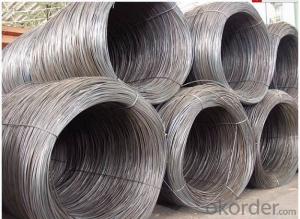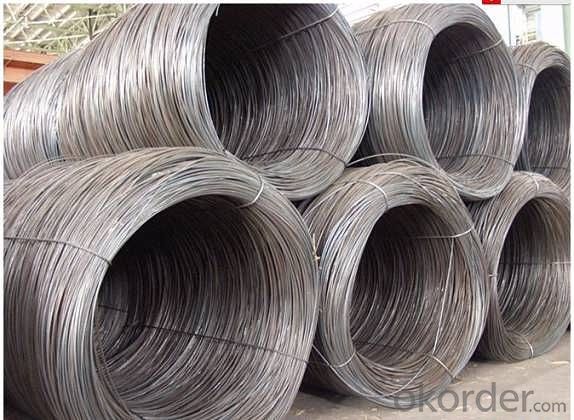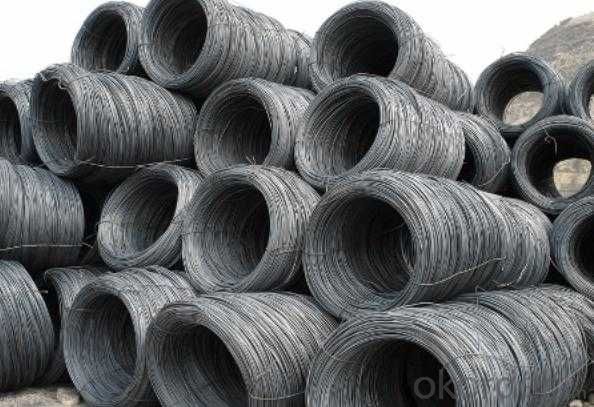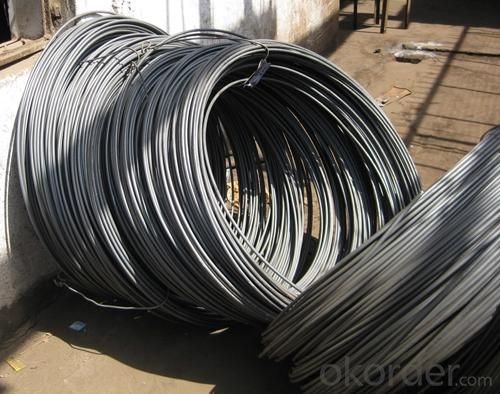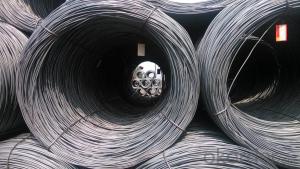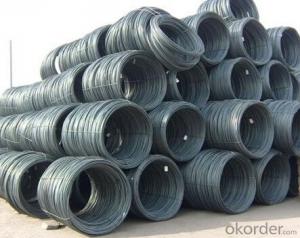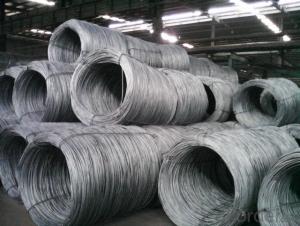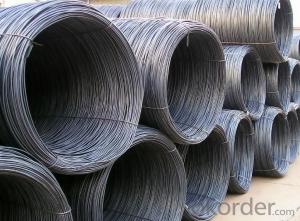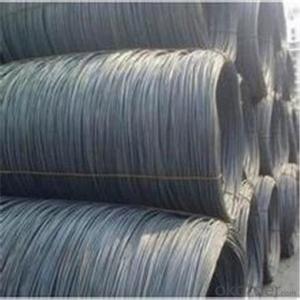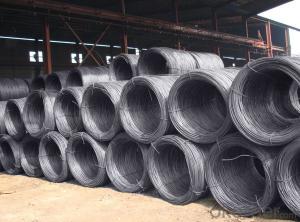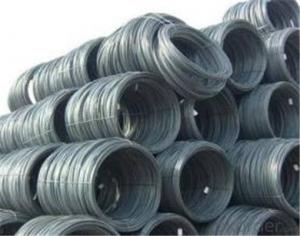High Quality Steel Wire Rod SAE1008 6.5mm
- Loading Port:
- Tianjin
- Payment Terms:
- TT or LC
- Min Order Qty:
- 50 m.t
- Supply Capability:
- 10000 m.t/month
OKorder Service Pledge
OKorder Financial Service
You Might Also Like
High Quality Steel Wire Rod SAE1008 6.5mm
Product Description:
Specifications of Wire Rod SAE1008:
Grade: SAE1008 Standard: ASTM
Diameter: 6.5mm
Alloy or Not: Alloy
Technique: Hot Rolled Place of Origin: China Mainland
Chemical Composition:
Please kindly find our chemistry of our material based on SAE1008 as below for your reference:
Grade | Chemical Composition (%) | |||||
C | Mn | S | P | Si | ||
SAE1008 | 0.10max | 0.32max | 0.045max | 0.040max | 0.30max | |
Mechanical properties | ||||||
Yield strength(N/mm2) | Tensile strength(N/mm2) | Elongation (%) | ||||
≥195 | 350-380 | ≥32 | ||||
Usage and Applications of High Quality Steel Wire Rod SAE1008 6.5mm:
After hot-rolled the products shaped into coil and delivery as finished product, including round, square,rectangular, hexagonal and so on. Since most of the products are round, it is generally called wire rod. Carbon steel wire rod is widely used in construction and manufacturing. Carbon steel wire rod is mainly used for reinforcement of reinforced concrete and welded structure or reprocessed (roberts , nail, etc.) materials, especially used to produce wire drawing, welding electrode, nails, spring, electronic, precise machinery parts and so on.
Packaging & Delivery of High Quality Steel Wire Rod SAE1008 6.5mm:
Packaging Detail: products are packed in coil and then shipped by container or bulk vessel
Each coil weight: About 2.05MT
Delivery Detail: within 45 days after received deposit or LC.
Label: to be specified by customer, generally, each bundle has 1-2 labels
Trade terms: FOB, CFR, CIF
FAQ:
Q1: Why buy Materials & Equipment from OKorder.com?
A1: All products offered byOKorder.com are carefully selected from China's most reliable manufacturing enterprises. Through its ISO certifications, OKorder.com adheres to the highest standards and a commitment to supply chain safety and customer satisfaction.
Q2: How do we guarantee the quality of our products?
A2: We have established an advanced quality management system which conducts strict quality tests at every step, from raw materials to the final product. At the same time, we provide extensive follow-up service assurances as required.
Q3: How soon can we receive the product after purchase?
A3: Within three days of placing an order, we will arrange production. The shipping date is dependent upon the quatity, how many sizes you want and the plan of production, but is typically 1 month to 2 month days from the beginning of production.
Images of High Quality Steel Wire Rod SAE1008 6.5mm:
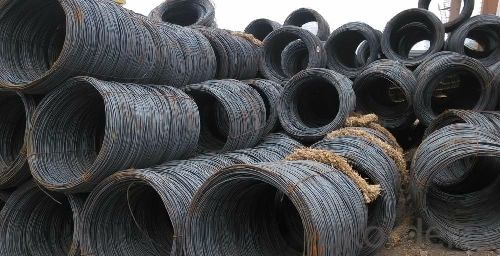
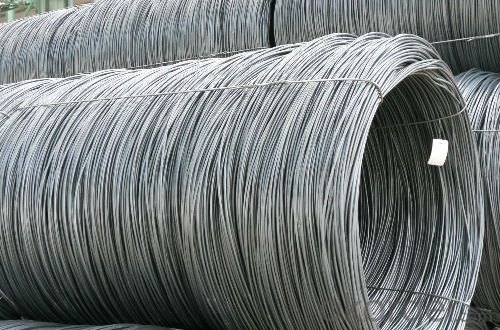
*If you would like to get our price, please inform us the size, standard/material and quantity. Thank you very much for your attention.
- Q: What are the main factors affecting the electrical conductivity of steel wire rod?
- The main factors affecting the electrical conductivity of steel wire rod include the composition and purity of the steel, the presence of impurities or alloying elements, the crystal structure and grain size of the steel, and the temperature at which the conductivity is measured.
- Q: How is steel wire rod used in the manufacturing of wire for shopping baskets?
- The manufacturing process of wire for shopping baskets heavily relies on steel wire rod. This rod acts as the primary material that undergoes a series of manufacturing steps to transform into wire. Initially, the steel wire rod is heated and passed through a set of rollers to gradually decrease its thickness and increase its length. This particular procedure, known as drawing, enhances the wire's tensile strength and flexibility. After the wire is drawn, it is typically coated with a protective layer to prevent corrosion and enhance its durability. This coating can be composed of materials such as zinc or plastic. Subsequently, the coated wire is shaped into the desired form, which is usually a mesh-like structure for shopping baskets. This shaping process, called welding, involves bending and joining the wire at specific points to form the basket shape. The selection of steel wire rod for manufacturing wire for shopping baskets is based on its strength, resilience, and ability to endure heavy loads. It ensures that the shopping baskets remain sturdy enough to carry various items without bending or breaking. Furthermore, the corrosion resistance properties of the steel wire rod guarantee a longer lifespan for the wire and ultimately the shopping baskets, even when exposed to moisture or challenging environments. In conclusion, steel wire rod plays a vital role in the manufacturing process of wire for shopping baskets. It serves as the fundamental raw material that is transformed into wire, which is then coated, shaped, and welded to create the final product. The strength, resilience, and corrosion resistance of the steel wire rod ensure that the shopping baskets are durable, long-lasting, and capable of withstanding the demands of everyday use.
- Q: How is steel wire rod used in the manufacturing of wire for automotive braking systems?
- Steel wire rod is used in the manufacturing of wire for automotive braking systems by being subjected to a series of processes such as drawing, annealing, and coating. These processes ensure that the steel wire rod is transformed into high-quality wire with the required strength and durability. The wire is then further processed to form specific components like brake cables, springs, and reinforcements, which are essential for the efficient functioning of automotive braking systems.
- Q: What are the common surface treatments for steel wire rod?
- The common surface treatments for steel wire rod include galvanizing, phosphating, powder coating, and painting.
- Q: What are the safety considerations for using steel wire rod in construction?
- Some safety considerations for using steel wire rod in construction include ensuring proper handling and storage to avoid injuries from sharp edges or falling objects, following proper installation procedures to prevent structural failures, and using appropriate personal protective equipment such as gloves and safety glasses to protect against potential hazards. It is also important to regularly inspect the wire rod for signs of wear, corrosion, or other damage that could compromise its strength and stability.
- Q: How is steel wire rod used in the manufacturing of wire mesh panels?
- Steel wire rod is used in the manufacturing of wire mesh panels as it serves as the raw material for creating the wires that form the mesh. The steel wire rod is typically drawn through a series of dies to reduce its diameter and increase its length, resulting in wires of various thicknesses. These wires are then woven or welded together to create the mesh pattern, forming a sturdy and durable panel that is commonly used for fencing, reinforcement, and filtration purposes.
- Q: How are steel wire rods stored to prevent corrosion?
- Steel wire rods are typically stored in a way that minimizes exposure to moisture and air, which are the primary causes of corrosion. To prevent corrosion, the rods are usually stored in a dry and well-ventilated area, away from direct contact with the ground and any potential sources of moisture such as water pipes or damp walls. They are often stored on pallets or racks, allowing for proper airflow and preventing contact with any surface that may contain water or excessive humidity. Additionally, steel wire rods are often coated with a protective layer, such as oil or a rust preventive compound, to further safeguard against corrosion during storage. Regular inspections and maintenance are also crucial to ensure that the storage conditions remain optimal and any signs of corrosion are promptly addressed.
- Q: What are the different mechanical tests conducted on steel wire rod?
- Some of the different mechanical tests conducted on steel wire rod include tensile strength testing, hardness testing, impact testing, and bend testing. These tests help determine the strength, durability, and flexibility of the steel wire rod, ensuring it meets the required specifications and standards for various applications.
- Q: What are the different types of packaging options available for steel wire rod?
- There are several different packaging options available for steel wire rod. The choice of packaging depends on factors such as the size and weight of the wire rod, its intended use, and the preferences of the buyer or manufacturer. One common packaging option for steel wire rod is coil packaging. In this method, the wire rod is coiled into a circular shape and then tightly wrapped with plastic or steel straps to secure it. Coils are often used for smaller diameter wire rods and are convenient for transportation and storage. Another packaging option is bundle packaging. In this method, several pieces of wire rod are bundled together and tightly bound with steel straps. Bundles are typically used for larger diameter wire rods and provide stability during transportation and handling. In addition to coils and bundles, steel wire rod can also be packaged in wooden crates or pallets. This method provides extra protection during transportation and can be used for both small and large diameter wire rods. Wooden packaging is often preferred when the wire rod needs to be shipped over long distances or stored for extended periods of time. Finally, some manufacturers may offer custom packaging options based on specific requirements. This could include special wrapping materials, additional protective measures, or unique packaging designs. Overall, the different types of packaging options available for steel wire rod ensure that the product is handled, transported, and stored in a safe and efficient manner, while also meeting the specific needs of the buyer or manufacturer.
- Q: What are the key success factors for companies in the steel wire rod industry?
- Companies operating in the steel wire rod industry can achieve success by focusing on various key factors. To begin with, maintaining a strong emphasis on quality is essential. Steel wire rod is widely used in industries such as automotive, construction, and electrical, so it is crucial to maintain high-quality standards that meet the requirements of different applications. Additionally, companies in this industry should strive for a robust and efficient manufacturing process. This involves investing in modern equipment and technology to improve production efficiency, reduce costs, and enhance overall productivity. Continuous improvement in process optimization and waste reduction is also necessary to remain competitive. Another critical factor is establishing a well-diversified customer base. The steel wire rod market is highly competitive, and companies must have solid relationships with a diverse range of customers to ensure a steady demand for their products. Developing long-term partnerships with customers and understanding their specific needs and preferences are vital for maintaining a competitive edge. Furthermore, effective supply chain management is vital for success. Companies need to secure a stable and cost-effective supply of raw materials, such as steel billets, to ensure uninterrupted production. Additionally, maintaining good relationships with suppliers and implementing efficient logistics strategies are essential to minimize lead times and meet customer demands promptly. Moreover, a strong focus on innovation and research and development is crucial in this industry. Companies that invest in developing new products, improving existing ones, and exploring new applications for steel wire rod will gain a competitive advantage. This can involve collaborating with customers, research institutes, and industry partners to stay ahead of market trends and offer innovative solutions. Lastly, companies in the steel wire rod industry should prioritize sustainability and environmental responsibility. This includes implementing sustainable manufacturing practices, reducing carbon emissions, and minimizing waste generation. Given the growing demand for environmentally-friendly products, companies that adopt and promote sustainable practices will be better positioned for long-term success. In conclusion, key success factors for companies in the steel wire rod industry encompass quality control, efficient manufacturing processes, a diversified customer base, effective supply chain management, innovation, and sustainability. By focusing on these factors, companies can position themselves for growth and competitiveness in the market.
Send your message to us
High Quality Steel Wire Rod SAE1008 6.5mm
- Loading Port:
- Tianjin
- Payment Terms:
- TT or LC
- Min Order Qty:
- 50 m.t
- Supply Capability:
- 10000 m.t/month
OKorder Service Pledge
OKorder Financial Service
Similar products
Hot products
Hot Searches
Related keywords
